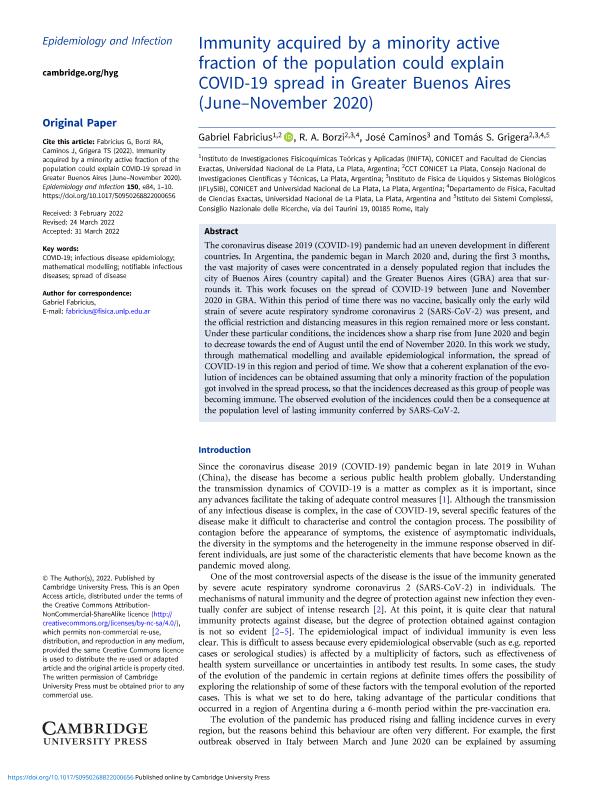Mostrar el registro sencillo del ítem
dc.contributor.author
Fabricius, Gabriel

dc.contributor.author
Borzi, Rodolfo Alberto

dc.contributor.author
Caminos, José María

dc.contributor.author
Grigera, Tomas Sebastian

dc.date.available
2023-09-22T14:43:53Z
dc.date.issued
2022-04
dc.identifier.citation
Fabricius, Gabriel; Borzi, Rodolfo Alberto; Caminos, José María; Grigera, Tomas Sebastian; Immunity acquired by a minority active fraction of the population could explain COVID-19 spread in Greater Buenos Aires (June-November 2020); Cambridge University Press; Epidemiology and Infection; 150; 4-2022; 84-84
dc.identifier.issn
0950-2688
dc.identifier.uri
http://hdl.handle.net/11336/212693
dc.description.abstract
The coronavirus disease 2019 (COVID-19) pandemic had an uneven development in different countries. In Argentina, the pandemic began in March 2020 and, during the first 3 months, the vast majority of cases were concentrated in a densely populated region that includes the city of Buenos Aires (country capital) and the Greater Buenos Aires (GBA) area that surrounds it. This work focuses on the spread of COVID-19 between June and November 2020 in GBA. Within this period of time there was no vaccine, basically only the early wild strain of severe acute respiratory syndrome coronavirus 2 (SARS-CoV-2) was present, and the official restriction and distancing measures in this region remained more or less constant. Under these particular conditions, the incidences show a sharp rise from June 2020 and begin to decrease towards the end of August until the end of November 2020. In this work we study, through mathematical modelling and available epidemiological information, the spread of COVID-19 in this region and period of time. We show that a coherent explanation of the evolution of incidences can be obtained assuming that only a minority fraction of the population got involved in the spread process, so that the incidences decreased as this group of people was becoming immune. The observed evolution of the incidences could then be a consequence at the population level of lasting immunity conferred by SARS-CoV-2.
dc.format
application/pdf
dc.language.iso
eng
dc.publisher
Cambridge University Press

dc.rights
info:eu-repo/semantics/openAccess
dc.rights.uri
https://creativecommons.org/licenses/by-nc-sa/2.5/ar/
dc.subject
COVID-19
dc.subject
INFECTIOUS DISEASE EPIDEMIOLOGY
dc.subject
MATHEMATICAL MODELLING
dc.subject
NOTIFIABLE INFECTIOUS DISEASES
dc.subject
SPREAD OF DISEASE
dc.subject.classification
Enfermedades Infecciosas

dc.subject.classification
Ciencias de la Salud

dc.subject.classification
CIENCIAS MÉDICAS Y DE LA SALUD

dc.subject.classification
Matemática Aplicada

dc.subject.classification
Matemáticas

dc.subject.classification
CIENCIAS NATURALES Y EXACTAS

dc.subject.classification
Epidemiología

dc.subject.classification
Ciencias de la Salud

dc.subject.classification
CIENCIAS MÉDICAS Y DE LA SALUD

dc.title
Immunity acquired by a minority active fraction of the population could explain COVID-19 spread in Greater Buenos Aires (June-November 2020)
dc.type
info:eu-repo/semantics/article
dc.type
info:ar-repo/semantics/artículo
dc.type
info:eu-repo/semantics/publishedVersion
dc.date.updated
2023-06-29T10:18:00Z
dc.journal.volume
150
dc.journal.pagination
84-84
dc.journal.pais
Reino Unido

dc.journal.ciudad
Cambridge
dc.description.fil
Fil: Fabricius, Gabriel. Consejo Nacional de Investigaciones Científicas y Técnicas. Centro Científico Tecnológico Conicet - La Plata. Instituto de Investigaciones Fisicoquímicas Teóricas y Aplicadas. Universidad Nacional de La Plata. Facultad de Ciencias Exactas. Instituto de Investigaciones Fisicoquímicas Teóricas y Aplicadas; Argentina
dc.description.fil
Fil: Borzi, Rodolfo Alberto. Consejo Nacional de Investigaciones Científicas y Técnicas. Centro Científico Tecnológico Conicet - La Plata. Instituto de Física de Líquidos y Sistemas Biológicos. Universidad Nacional de La Plata. Facultad de Ciencias Exactas. Instituto de Física de Líquidos y Sistemas Biológicos; Argentina
dc.description.fil
Fil: Caminos, José María. Consejo Nacional de Investigaciones Científicas y Técnicas. Centro Científico Tecnológico Conicet - La Plata. Instituto de Física de Líquidos y Sistemas Biológicos. Universidad Nacional de La Plata. Facultad de Ciencias Exactas. Instituto de Física de Líquidos y Sistemas Biológicos; Argentina
dc.description.fil
Fil: Grigera, Tomas Sebastian. Consejo Nacional de Investigaciones Científicas y Técnicas. Centro Científico Tecnológico Conicet - La Plata. Instituto de Física de Líquidos y Sistemas Biológicos. Universidad Nacional de La Plata. Facultad de Ciencias Exactas. Instituto de Física de Líquidos y Sistemas Biológicos; Argentina
dc.journal.title
Epidemiology and Infection

dc.relation.alternativeid
info:eu-repo/semantics/altIdentifier/url/https://www.cambridge.org/core/journals/epidemiology-and-infection/article/immunity-acquired-by-a-minority-active-fraction-of-the-population-could-explain-covid19-spread-in-greater-buenos-aires-junenovember-2020/13E0E331D58D1EB80D32541A2B49FF64#article
dc.relation.alternativeid
info:eu-repo/semantics/altIdentifier/doi/http://dx.doi.org/10.1017/S0950268822000656
Archivos asociados
